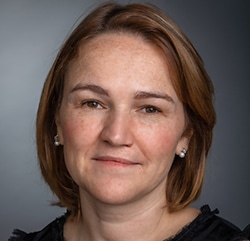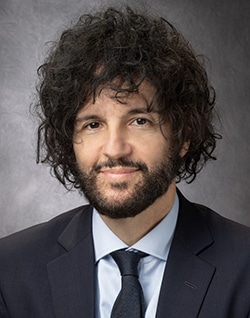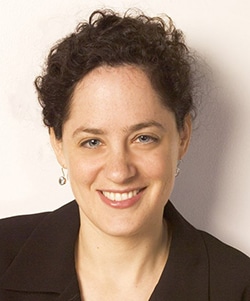SABCS 2023: Defining and Demystifying Inflammatory Breast Cancer
In 1994, at the age of 40, Ginny Mason, RN, began noticing some concerning differences in the size and color of one of her breasts, accompanied by new shooting pains.
The radiologist who reviewed her mammogram called her a hypochondriac and sent her home. Her primary care physician counseled her to take an anti-inflammatory drug and cut back on caffeine because her symptoms were likely due to a fluid-filled cyst. It wasn’t until Mason visited a surgeon for an unrelated problem and asked him to take a look that she was offered a biopsy, which revealed a rare but aggressive form of breast cancer that gave Mason a 3% chance of surviving the next five years.
“It took me almost five months to get a diagnosis, and I’m just amazed that I did not have metastatic disease by that point,” Mason told the attendees of the 2023 San Antonio Breast Cancer Symposium (SABCS), held December 5-9, during an educational session about inflammatory breast cancer (IBC), the disease that changed the trajectory of her life. The topic was selected as the People’s Choice Educational Session after nomination and voting by past SABCS attendees.

“I’m so grateful to all of you who voted for an inflammatory breast cancer session,” Mason said. “We were cheering when we learned that we received this opportunity.”
As executive director of the Inflammatory Breast Cancer Research Foundation, Mason has been fighting for patients with IBC for almost 25 years. While IBC research has come a long way since 1994, patients still struggle to receive an accurate and timely diagnosis and understand their treatment options.
Much of the confusion stems from IBC’s ambiguous symptoms and presentation, explained Filipa Lynce, MD, senior physician and director of the Inflammatory Breast Center at Dana-Farber Cancer Institute, an assistant professor of medicine at Harvard Medical School, and moderator of the session. Lynce described the diagnostic criteria for IBC, including:
- A concurrent diagnosis of invasive (stage 3 or 4) breast cancer
- Rapid progression within six months
- Erythema (skin redness) involving one-third or more of the affected breast
- In some cases, swelling, warmth, a palpable mass, dimpled or pitted skin (peau d’orange), and involvement of the dermal lymph nodes
Because many of these symptoms are nonspecific, physicians may not immediately realize what they’re dealing with, Lynce noted. For this reason, a group of breast cancer researchers recently devised a new scoring system to aid with the diagnosis and stratification of IBC cases to guide patients toward the best treatment options.
Despite the ambiguous nature of IBC, the recommended treatment for patients with localized disease is relatively standard, explained Anthony Lucci, MD, a professor in the Department of Breast Surgical Oncology at the University of Texas MD Anderson Cancer Center. The suggested regimen, known as trimodal therapy, consists of neoadjuvant chemotherapy followed by a radical mastectomy and radiation; patients may also receive HER2-targeted therapy or antiestrogen therapy if their tumors express the appropriate targets.

However, a 2014 study showed that only 40% of patients successfully completed trimodal therapy, and a poster presented at SABCS suggested the number may be as low as 25%.
“I would submit that things aren’t necessarily getting better. In an era of de-escalation, are [patients] not getting guideline care as often?” Lucci said.
Lucci argued that the evidence in favor of breast-conserving surgery, in which only a portion of the affected breast is removed, is not sufficient to convince him that the practice is safe for patients with IBC. In a study of over 7,000 patients with IBC, those who underwent breast-conserving surgery had a significantly lower five-year survival rate than those who underwent a total mastectomy.
Instead of de-escalating surgery, Lucci suggested prioritizing clear disease margins in the surgical plan and involving plastic surgeons early to optimize breast reconstruction efforts. In a study in which 261 of 262 patients with IBC had clear margins after resection, the five-year probability of locoregional recurrence was 6.5%, and the five-year overall survival rate was 70% —rates Lucci said were similar to those observed in patients with non-IBC.
Lucci suggested that radical mastectomy may also benefit patients with metastatic IBC—a stark contrast from metastatic non-IBC cases, in which surgery is rarely recommended. He cited two studies wherein mastectomies significantly improved the overall survival of patients with metastatic IBC.
Jennifer R. Bellon, MD, director of breast radiation oncology at Dana-Farber Cancer Institute and an associate professor of radiation oncology at Harvard Medical School, agreed with the potential for localized therapy to benefit patients with metastatic IBC. In one study, patients who received locoregional radiation and/or surgery had a median survival of 24 months, while those who didn’t receive locoregional therapy had a median overall survival of 17 months. Other studies showed that locoregional therapy could decrease the odds of both local and distant recurrence.

Locoregional treatment may cause significant side effects, however. “I think it’s important to keep in mind the morbidity of local treatment,” Bellon said. “While the morbidity is not overwhelming, it is significantly increased across multiple domains in the patients undergoing local therapy. It’s not something to be taken lightly.”
A research group at Dana-Farber Cancer Institute aims to explore the risks and benefits of locoregional therapy through a prospective registry. Patients with metastatic IBC decide with their doctors whether to receive locoregional therapy and are asked to complete surveys about their quality of life during treatment and follow-up.
Maximizing potential benefit may also involve identifying patient populations whose cancers respond particularly well to locoregional therapy. For instance, a study of patients with metastatic HER2-positive disease who were also receiving HER2-targeted therapy showed that while 29% of patients who did not receive surgery had a locoregional progression within two years, none of the patients who received surgery (80% of whom also received radiation) did.
“It’s a suggestion that maybe these patients who are benefiting from improvements in systemic therapy … may be a select group that benefits from more aggressive locoregional therapy despite having metastatic disease,” Bellon said.
Some researchers are working to identify IBC-specific drug targets to offer systemic therapy to more patients, but they have faced difficulties, explained Frederick Howard, MD, an instructor of medicine at the UChicago Medicine Comprehensive Cancer Center.

While several groups have tried to identify a genomic signature characteristic of IBC, they’ve found that IBC cases tend to be more genomically similar to non-IBC cases of the same molecular subtype, defined by hormone receptor and HER2 expression; no set of genomic factors could accurately differentiate IBC from non-IBC cases.
Nevertheless, Howard identified a few molecular pathways that warrant further investigation. “There’s not a single unique genomic pathway to inflammatory breast cancer, but there are some interesting findings that may underlie its biology,” he said.
Two studies, one from 2018 and another from 2020, found that IBC had a significantly higher incidence of mutations in the Notch signaling pathway, which can boost cancer cells’ growth and metastatic potential. Silencing Notch3 in a patient-derived organoid model of IBC led to slower growth and impaired assembly of spheroids, a formation that can help cells metastasize.
Some IBCs also express hemoglobin, which is typically only expressed in blood cells but, when expressed in cancer cells, can be a sign of tumor aggressiveness. “This expression may be adaptive, allowing cells to travel in the blood and form metastases,” Howard hypothesized.
Further, IBC interacts uniquely with its tumor microenvironment. Tumor-promoting macrophages were among the most prevalent cell types isolated from IBC tumors. Using inflammatory cytokines, IBC tumors can recruit these macrophages, as well as macrophage precursors. In a mouse model of IBC, silencing those cytokines decreased both macrophage recruitment and redness of the mammary tissue.
While these findings are preliminary, such progress is welcomed by patient advocates who have faced plenty of obstacles and ambiguity in their IBC journeys.
“We hear a lot of ‘we don’t know’ or ‘we don’t have,’ but hope lives in this research, and I’m not discouraged by that,” said Terry Arnold, founder of the IBC Network Foundation.
Arnold further stressed that as new information becomes available, it needs to be effectively communicated. “We need to expand that knowledge base to other medical expertise … not only medically, but also into the community, so we can have the tools to be good advocates for ourselves,” she said.
Naomi John, vice chair of the IBC Network UK, echoed this point and emphasized the importance of patient advocacy in bridging the gaps. “Until we have a global protocol in place that is universally accepted … that’s where our advocacy comes in: to make sure that [patients] can receive the best possible care.”



